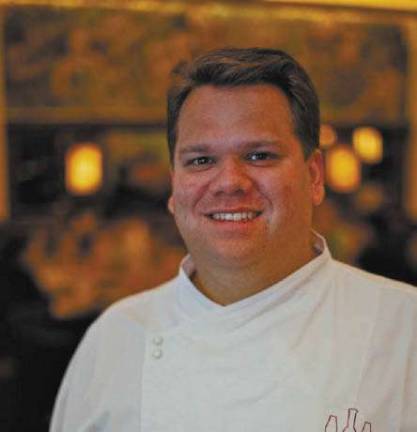Every Day is Your Birthday in the West Village


Harold Moore brings international flavor - and fantastic bread - to his restaurant Commerce
[](http://nypress.com/wp-content/uploads/2013/10/Celeb_Harold-Moore_opt.jpeg)On the dessert menu at Commerce, there is always birthday cake. It's yellow with chocolate frosting and sprinkles and always served with a lit candle, even if it's not your birthday. "It's an immediate smile," said Chef Harold Moore of his celebratory creation. It's a little touch like this - and a superfluous, homemade bread basket - that sets this restaurant apart as a fan favorite in the West Village. Moore started his career in New York at the top, landing a job at Daniel because he was willing to work for free. "I looked at it as an investment in my career and it's paid dividends," he said. Now, the 40-year-old gets to create a menu of his own and use his culinary knowledge to reinvent classic dishes to satisfy his customers' palates. For the fall season, he's working on a vegetable pot-au-feu, with the broth an unexpected blend of burnt onions and apple juice. "You get this marginally sweet and smoky broth that's so delicious," he said. On November 11th, Moore will join over 40 chefs at New York Taste, which is sponsored by New York magazine and benefits City Harvest.
When did you know you wanted to become a chef?
I've always loved food, but when I was young, cooking was not the sexy job that it is today. So I kind of fought it when I was in high school and college. I didn't fully connect to it until I was 22.
You said that Daniel Boulud changed your life. How?
Before that - I hate to say it - I was just raw and average. And it was there [Daniel], with the extreme discipline and the really high standards, that I became a different person. He just whipped me into shape. I mean, I was willing to do it, but if it wasn't for him, I wouldn't be here today.
The building that Commerce is in dates back to 1911 and was a speakeasy during the Depression. How did you take that into account when you planned the restaurant's décor?
A good space in New York has real personality and when we got here, there was nothing inside other than the floor and tile work. I'm a big one for respecting tradition and honoring the past, and this place, it had such a history, that there was no way to avoid it. We took on this project that really became a 14-month exercise in restoration.
It's tucked away on Commerce Street. How did people find you in the beginning?
By luck. A lot of people were calling. Now, everyone has a smartphone, so it's easier. But when we first started, the GPS on the iPhone was just starting to take hold. So if they didn't know about it, it was hard to get to, but fortunately, the restaurant that was here before us [Grange Hall] was very popular and people in the neighborhood knew it, so it made it easier for them to get here.
[](http://nypress.com/wp-content/uploads/2013/10/Celeb_Cake_opt.jpeg)How did you choose the West Village as the neighborhood to open in?
I believed at the time, and still do, that this is one of the most vibrant food neighborhoods in the city. It was definitely more casual than what I was used to, so I had to change my way, and adjust from what I was doing in fancy restaurants like Marche, Daniel, and Montrachet and do something a little more rustic and more fun in a way.
How did the menu item Ragu of Odd Things come about?
I really loved tripe Lyonaisse, and wanted to do a rendition of that, but something more my own because I'm not a French guy. I decided to use pig's feet. At the time I was eating at lot in Chinatown because I was broke since the restaurant wasn't open yet. I had a stew of tripe and oxtail and it was delicious. The pigs feet gives you the gelatin, and if you put a little bit of the oxtail inside, it competes with the flavor and makes it a little bit more palatable.
Do vegetarians complain?
In general, they always do, but not about the tripe dish. We have a fair amount of vegetarian options on the menu and that's really been the focus of my fall this year. I've been working not so much with meat and fish, but with vegetables. We have this dish, mushroom cannelloni, that has these beautiful porcini from France, chanterelles, and a variety of other mushrooms rolled inside fresh pasta with a truffle glaze.
How did the brunch item, the Israeli Working Man's Breakfast Pita, come about?
My original chef de cuisine here was Israeli and he was like, "In my country we do pita, hummus, and all this other stuff." And I was like, "There is no way Americans are going to eat that; you're crazy." Then I said, "Alright, let's do it and get it out of your system." It turns out to be one of the most delicious things and bridges that gap between breakfast and lunch.
Is it really true that you cooked a million burgers to get yours right?
Not a million, but close to 100, yeah. I never cooked hamburgers professionally before and it turns out it's pretty hard.
You're famous for your homemade, overflowing bread basket. How much bread do you go through in a day?
We use roughly 50 pounds of flour in a day. That's about 900 - 1,000 rolls. It's spread out over 11 or 12 different varieties depending on the day. Our bread program is not traditional, so the break baker works during the day when the cooks are here. The bread is literally not done until 5 o'clock, where in most bread programs, the baker comes super early in the morning.
You're a quarter Japanese and your family inspired one of your dishes.
I am. Yeah, my grandmother. Beef tataki, or beef deckle "toro," which is what we call it now.
You have some entrees meant for sharing. Is this a good date spot?
It's a great date spot. It's very fun and lively, especially when a relationship is new, because there are so many interesting things to talk about. There's a lot of good people watching. There's always a celebrity or two around.
You have two kids. How do you make time for your family when you're so busy?
You just have to be disciplined about it. Sundays are carved-out family days. I try to take them to school every morning, so that's the big one.
If you had to take your family out to a restaurant in Manhattan, where would you go?
Peasant. I always get the tripe. If they have sardines on their menu, I always get that. And some variation of rabbit is always good there.
I read that you're opening another restaurant.
I want to do a more rustic version of Commerce - more ingredient focused and a little less idea driven. Commerce is still a very idea-driven restaurant, and I want to do something that's more seasonal, more soulful in the way of country French cooking or peasant Italian cooking, that really focuses on those old recipes.
To learn more about Commerce, visit www.commercerestaurant.com
Follow Chef Moore on Twitter: @ChefHaroldMoore